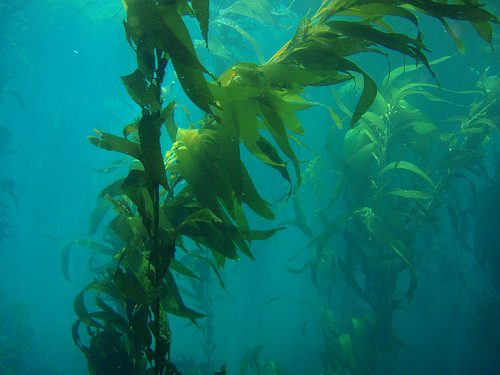Don’t mistake undersized kelp for young giant kelp.
- Giant kelp is a species of large seaweed, native to the waters of the eastern Pacific, as well as southern South America, South Africa and Australia.
- ‘Giant kelp’ is also known as ‘giant bladder kelp’ and ‘string kelp’, and the plant has large leafy blades that grow on long stems known as ‘stipes’, and to assist the plant to float or stay upright in the water, there is a ‘pneumatocyst’ (a bladder filled with gas) at the bottom of each blade.
- The scientific name of giant kelp is Macrocystis pyrifera and it is from the family Laminariaceae, the family of brown algal seaweed.
- Giant kelp can grow up to 40 to 65 metres (44 to 71 yards) in height, and as such, is the earth’s largest ocean plant.
- With a potential growth rate of up to 60 centimetres (2 feet) daily, giant kelp is among the fastest growing wildlife known.
Giant Kelp
Image courtesy of NOAA Photo Library/Flickr
- Young giant kelp grow from the trillions of spores released from the reproductive blades near the bottom of the mature kelp plant, and the young kelp will latch onto a sturdy base, such as a rock, using a root-like system, known as a ‘holdfast’.
- Giant kelp is common among ecosystems in providing shelter for numerous aquatic life in the form of kelp beds and forests.
- Giant kelp can be eaten by humans, and contains a high potassium and iodine content, and the plant has historically been used to create potash, while in modern times it is used as a fertiliser; commonly as an emulsifier; and for chemical purposes in various industries.
- Typically, giant kelp is found at depths of 5 to 20 metres with a water temperature of 6°C to 20°C (43°F to 68°F).
- Giant kelp is a perennial seaweed, however the blades, or ‘fronds’ as they are also known, last only for a few months or up to a year, after which they die, although the plant continues to grow new ones.
Bibliography:
Bushing W, Giant Bladder Kelp, n.d, Star Thrower, http://www.starthrower.org/research/kelpmisc/kelp_mp.htm
Edyvane K, Conservation, Monitoring & Recovery of Threatened Giant Kelp (Macrocystis pyrifera) Beds in Tasmania – Final Report, 2003, Australian Government Department of Environment, https://www.environment.gov.au/system/files/pages/f250cead-de41-4b9d-9a52-91d5cb66f6b1/files/co01kelp.pdf
Macrocystis Pyrifera, 2015, Wikipedia, https://en.wikipedia.org/wiki/Macrocystis_pyrifera







